Membranes for redox-flow-batteries (RFB)
The redox-flow-battery (RFB) systems are complementary devices for pairing of the green electricity production with energy storage systems in range between 100kWh and 1.000 MWh. The RFBs are facilitating frequent load changes on input while featuring easy maintenance, scalability, robust operation parameters and very advantageous CAPEX for its longevity. The key part of the system is the membrane that determines the efficiency of the process.
The main portion of RFB installations is built with vanadium redox-flow-battery (VRFB). The VRFB are based on electrolyte made from water-soluble vanadium sulfate species. The vanadium charge bearers are separated by a membrane that also transports the released counterpart of vanadium ions. Depending on the system, one can use either cation-exchanged membranes transporting protons and featuring high power density or anion-exchanged membranes transporting sulfate ions and featuring easy management and high efficiency.
The overview of the membrane’s properties is summarized in the following table:Typical properties of fumasep membranes used for VRFB
| Membrane | FAP-450 | FAPQ-330 | FS-940 | FS-930 |
| Conductor | anionic | anionic | cationic | cationic |
| Thickness / µm | 50 | 30 | 40 | 30 |
| Typical curr. density /mA.cm2 | 80-150 | 100-250 | 100-250 | 150-400 |
| Coul. Efficiency / % (1) | >98 | >98,5 | >97,5 | >96 |
| Resistance / mOhm.cm2 (2) | 650 | 350 | 320 | 190 |
| Capacity retention / % (3) | ~ 100 | ~ 100 | ~99,9 | ~99,9 |
Remark:
(1) Mean values measured at 150 mA/cm2
(2) Mean values measured at 25 °C and 50% SOC by EIS in cell-test as HFR
(3) Anion-exchanged membranes operate in electrolyte-rebalancing mode, cation-exchanged membranes operate in electrolyte-remixing mode or hybrid remixing-rebalancing mode
Download
| Technical Datasheet - fumasep FAP-450 | PDF, 124 Kb | Downloads | |
| Technical Datasheet - fumasep FAPQ-330 | PDF, 127 Kb | Downloads | |
| Technical Datasheet - fumasep FS-940 | PDF, 126 Kb | Downloads | |
| Technical Datasheet - fumasep FS-930 | PDF, 123 Kb | Downloads |
Organic redox-flow-battery (ORFB)
Some recent systems of RFB are based on the organic electrolytes that are more economical compared to vanadium electrolyte. Depending on the type of transferred ions, either cation-exchanged membranes transporting sodium or potassium ions or anion-exchanged membranes transferring chloride or sulfate ions are used for organic redox-flow-battery (ORFB). The most characteristic membrane and their properties are summarized in Table 2.
Typical properties of fumasep membranes used for ORFB
| Fumasep membrane | FAA-3-30 | FAPQ-330 | E-620(K) |
| Conductor | anionic | anionic | cationic |
| Thickness / µm | 30 | 30 | 20 |
| Operational pH limit | 0-13 | 0-8 | 0-14 |
| Selectivity / % (1) | > 97,5 | > 95 | > 98,5 |
| Resistance / mOhm.cm2 (2) | 1300 | 400-1000 | 600 |
Remark:
(1) Measured in KCl concentration cell 0,1M/0,5M
(2) Measured at 25 °C and in NaCl/KCl solutions and pH=7 in a resistance cell; FAPQ-330: lower value of resistance measured at pH=3, higher value of resistance at pH=7
Download
| Technical Datasheet - fumasep FAA-3-30 | PDF, 132 Kb | Downloads | |
| Technical Datasheet - fumasep FAPQ-330 | PDF, 127 Kb | Downloads | |
| Technical Datasheet - fumasep E-620(K) | PDF, 132 Kb | Downloads |
Further products for your applications
Contact














